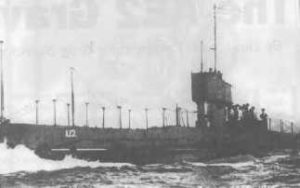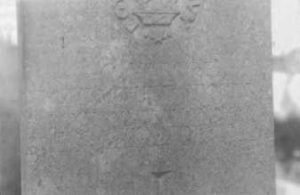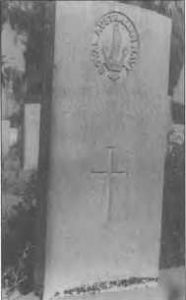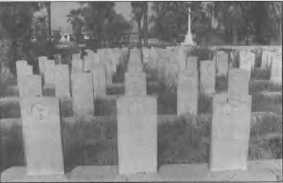- Author
- Swinden, Greg
- Subjects
- Ship histories and stories, WWI operations
- Tags
-
- RAN Ships
- HMAS AE2
- Publication
- December 1998 edition of the Naval Historical Review (all rights reserved)
In the Baghdad North Gate Cemetery (Iraq) are the graves or memorials of four RAN sailors who died during World War I. Who were these men? How did they come to be buried here? Hundreds of miles from where they died and even further from where they wrote an undying page in Australia’s naval history.

When the Australian submarine AE2 penetrated the Dardanelles in the early hours of April 25, 1915 she made naval history as the first Allied submarine to breach this well defended waterway. Five days later on April 30 she was attacked and sunk by a Turkish gunboat and her crew of 32 was made Prisoners of War. Her story is well known.
The men commemorated at Baghdad were the four crewmen from the AE2 who did not survive the next three and a half years in captivity. The Turks put the POW’s to work doing manual labour, notably on the railway lines in Southern Turkey near the Taurus Mountains. The men worked long and hard in difficult and often freezing conditions. It was not long before the effects of malnutrition, exposure, exhaustion and disease began to take their toll (shades of another war and a different group of Australian POWs).

The first to die was Chief Petty Officer Stoker Charles Varcoe who died of meningitis on September 18, 1916 while at the POW Camp of Belemedik. In Greg Kerr’s book “Lost ANZAC’s” his grandfather, Corporal Kerr (an Australian POW from the 14th Battalion captured at Gallipoli) records Varcoe’s death – “Charlie Varcoe who had been ailing for some time went to hospital yesterday and on his way fell down unconscious. He was picked up by one of our lads and admitted to hospital. In the afternoon the doctor sent down a message to the effect that Charlie would die in an hour. He had not regained consciousness. In the morning we were told he had died at 7 o’clock in the morning. He was buried the same afternoon.”
Varcoe was a Royal Navy sailor on loan to the RAN and left a widow in England.
Within a month three other AE2 crewmen had died. On or about September 29, 1916 Stoker Michael Williams is alleged to have died at Bozanti, sometimes referred to as Pozanti, of disease (some sources cite it as dysentery and others as malaria). Following his death his body was not recovered and it is believed he was buried in an unmarked grave. It was recorded at the time by another AE2 crewman that the Turks were `doing away’ with the sicker POWs, and while there is no proof that Williams was murdered his disappearance certainly remains a mystery.
Williams was only 22 years old and had joined the RAN in 1912 from Hamilton in Victoria. Three of his brothers were also killed during the war while serving in the AIF.
A plague of typhus swept the POW camp at Belemedik in October 1916 and on October 9 Petty Officer Stephen Gilbert died. He was followed on October 22 by Able Seaman Albert Knaggs. Again Corporal Kerr recorded the events – “Gilbert of AE2 died this morning. It is thought to be typhoid. He had been in hospital for a fortnight.” Another POW recorded – “Petty Officer Gilbert died of a very high fever and was buried. All available prisoners followed him (his coffin) to the grave”. Gilbert’s death is recorded by the Navy as occurring on October 9, but other sources state it was in late September.

Gilbert was an ex Royal Navy sailor who had joined the RAN in 1913. Albert Knaggs was also an ex-Royal Navy and although he did not survive the war his diary of his time in AE2 and as a Prisoner of War did. Copies of his diary are now held at the Australian War Memorial and the Submarine Museum at Spectacle Island in Sydney.
At the conclusion of hostilities in November 1918, the bodies of Allied servicemen lay in thousands of small cemeteries and individual gravesites across the globe. The Commonwealth War Graves Commission charter stated that it was to commemorate all Allied sailors, soldiers and airmen who had fallen in the war. To do so was a mammoth task, which would take years to complete. To make this task easier many bodies were moved from their original remote burial sites to those more accessible.
As a result the Commonwealth War Graves Commission began to relocate the graves of Allied servicemen who had died as Prisoners of War in Turkey. These included the bodies of Varcoe, Gilbert, Knaggs and several British submariners from the submarine HMSS E7 (sunk in the Dardanelles in September 1915). As Stoker William’s grave could not be found he was commemorated on a special memorial.
By 1922 the Baghdad North Gate Cemetery held nearly 6,000 graves, mainly of those killed in the fighting in the Mesopotamian Campaign. Among these were the graves or memorials for 35 Australians who had died as Prisoners of War. Ten men whose bodies could not be located are recorded on the Bozanti, Nisibin or Angora Memorials.

The grave in the centre is that of Petty Officer Gilbert flanked by two sailors from HM Submarine E7.
Apart from the four sailors from AE2 there were men from infantry battalions captured at Gallipoli, Light Horsemen captured in the campaign in Palestine, and Australian Flying Corps ground crew captured at the fall of Kut-el-Amara in April 1916. Also buried at Baghdad are six Australians from the 1st ANZAC Wireless Signal Squadron who fought with the British forces during the Mesopotamian campaign of 1917-18.
So the men from AE2 lie far from their homes and loved ones in the War Cemetery at Baghdad. They are, however, in good company.
Lest we forget.
Bibliography.
Adam-Smith P Prisoners of War, Viking Press (Penguin Books Australia Ltd), Australia, 1992.
Coulthard-Clark C. Where Australians Fought – The Encyclopedia of Australia’s Battles, Allen and Unwin. Australia 1998.
Frame T R. and Swinden G.J. First In – Last Out, The Navy at Gallipoli, Kangaroo Press Svdney 1990.
Kerr G. Lost ANZAC’s, Oxford University Press, Melbourne 1997.
Smyth D. The Submarine AE2 in World War I, Naval Historical Society of Australia Monograph, 1974.
White M.W.D. Australian Submarines-A History, Australian Government Printing Service, Canberra, 1992.
Wilson M. Destination Dardanelles, Leo Cooper Ltd (of the Heinemann Group), London, 1988.
Photographs courtesy of Lieutenant Mark Bolt, RAN and Petty Officer “Shiner” Wright (Royal Navy) – UN Observers stationed in Baghdad




